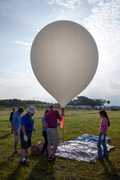Global Tropospheric Experiment - Atmospheric Boundary Layer Experiment
Atmospheric Composition, Carbon Cycle & Ecosystems
- 5
- view all deployment datesDeployments
1984-06-13 1984-06-30 1987-04-13 1987-05-08 1988-07-07 1988-08-17 1990-07-06 1990-08-15 1985-07-11 1985-08-15 - 3
- Platforms
- 25
- Data Products
The Campaign
The Atmospheric Boundary Layer Experiment (ABLE) was a NASA campaign that investigated how emissions from the biosphere interacted with the boundary layer. ABLE included five deployments during the boreal spring and summer from 1984 to 1990 across three different study regions: the Tropical North Atlantic Ocean, the Amazon Rainforest, and the Arctic areas of North America. NASA’s Electra aircraft was equipped with in situ and remote instruments to gather measurements of trace gases, ozone, and aerosols in the atmosphere. ABLE was funded by NASA’s Tropospheric Chemistry Program and was part of the Global Tropospheric Experiment (GTE) program.
Atlantic Boundary Layer Experiment, Amazon Boundary Layer Experiment, Arctic Boundary Layer Experiment, ABLE-1, ABLE-2, ABLE-3
N: 76°N
S: 10°S
W: 170°W
E: 35°W
no campaign DOI available
- An overview of the ABLE-1 deployment
- ASDC Landing Page for ABLE-2
- An overview of the ABLE-2A deployment
- ASDC Landing Page for ABLE-3
- An overview of the ABLE-2B deployment
- An overview of the ABLE-3A deployment
- An overview of the ABLE-3B deployment
- Summary of the ABLE campaign
- Data access to Global Tropospheric Experiment (GTE) campaigns
Additional Notes
Repositories

Field Site

Lockheed L-188C Electra

Balloon Launch Site

Lockheed L-188C Electra

Field Site

Lockheed L-188C Electra

Field Site

Lockheed L-188C Electra
Events
Filter data products from this campaign by specific platforms, instruments, or formats.